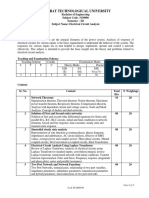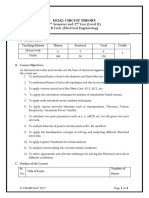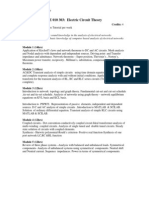0 ratings0% found this document useful (0 votes)
Syllabus Na
Syllabus Na
Uploaded by
Anonymous I13s99This document provides an overview of the BTEEC 302 Network Analysis and Synthesis course. The course is a 3 credit course taught over 6 units. It covers topics such as active and passive circuit elements, network equations, solving network equations using Laplace transforms, two port networks, and sinusoidal steady state AC circuits. The goal is to review basic network components, design network equations and solutions, and analyze AC circuits using techniques like Laplace transforms and network theorems. Assessment includes a midterm test, internal assessment, and end of term exam.
Copyright:
© All Rights Reserved
Available Formats
Download as PDF, TXT or read online from Scribd
Download as pdf or txt
Syllabus Na
Syllabus Na
Uploaded by
Anonymous I13s990 ratings0% found this document useful (0 votes)
This document provides an overview of the BTEEC 302 Network Analysis and Synthesis course. The course is a 3 credit course taught over 6 units. It covers topics such as active and passive circuit elements, network equations, solving network equations using Laplace transforms, two port networks, and sinusoidal steady state AC circuits. The goal is to review basic network components, design network equations and solutions, and analyze AC circuits using techniques like Laplace transforms and network theorems. Assessment includes a midterm test, internal assessment, and end of term exam.
Original Description:
Network analysis d BAT Univ
Original Title
syllabus na
Copyright
© © All Rights Reserved
Available Formats
PDF, TXT or read online from Scribd
Share this document
Did you find this document useful?
Is this content inappropriate?
This document provides an overview of the BTEEC 302 Network Analysis and Synthesis course. The course is a 3 credit course taught over 6 units. It covers topics such as active and passive circuit elements, network equations, solving network equations using Laplace transforms, two port networks, and sinusoidal steady state AC circuits. The goal is to review basic network components, design network equations and solutions, and analyze AC circuits using techniques like Laplace transforms and network theorems. Assessment includes a midterm test, internal assessment, and end of term exam.
Copyright:
© All Rights Reserved
Available Formats
Download as PDF, TXT or read online from Scribd
Download as pdf or txt
0 ratings0% found this document useful (0 votes)
Syllabus Na
Syllabus Na
Uploaded by
Anonymous I13s99This document provides an overview of the BTEEC 302 Network Analysis and Synthesis course. The course is a 3 credit course taught over 6 units. It covers topics such as active and passive circuit elements, network equations, solving network equations using Laplace transforms, two port networks, and sinusoidal steady state AC circuits. The goal is to review basic network components, design network equations and solutions, and analyze AC circuits using techniques like Laplace transforms and network theorems. Assessment includes a midterm test, internal assessment, and end of term exam.
Copyright:
© All Rights Reserved
Available Formats
Download as PDF, TXT or read online from Scribd
Download as pdf or txt
You are on page 1/ 1
BTEEC 302. NETWORK ANALYSIS AND SYNTHESIS.
Teaching scheme: Examination Scheme:
Theory: 2 hrs Mid-term test: 20 Marks
Tutorial: 1 hr Internal Assessment: 20 Marks
Total credit: 3 End semester exam: 60 Marks
Pre Basic electrical engineering
requisite
Course To review basic components of electric network.
Outcome To design and develop network equations and their solutions.
To apply Laplace theorem for electric network analyses
To analyze AC circuit.
Unit Contents Contact
Hrs
1 Active & Passive Circuit Element: Independent & dependent voltage & current sources, R, L, C & mutual 6
inductance circuit parameters, Their mathematical modes, Voltage current power relations.
Classification of element: Lumped distributed, Linear & non-linear, Unilateral, Bilateral, Time invariant &
variant, Pace invariant & variant, Super position, Thevenin’s, Norton’s Reciprocity, Maximum power
transfer, Substitution, Tellegen's theorem.
2 Network Equations: Network topology, Graph, Tree, Branches, Chords, Equilibrium equation on loop basis & 6
node basis Number of network equation required, Choice between nodal & loop analysis, Source
transformation, Network mutual inductance, Dot conventions, Concept of super mesh, Super node Concept of
duality & dual networks.
3 Solution of Network Equations: Classification solution of first, Second order differential equations of series & 6
parallel R-L, R-C, R-L-C circuits, General & particular solutions, Particular integral & complimentary
functions, Time constant, Mathematical analysis of circuit transients, initial conditions in network, Procedure
of evaluality, Conditions in network problems, Solution of D.C. resistive network & A. C. sinusoidal steady
state networks, Writing loop equations, Node equations directly in matrices form. Numericals
4 Application of Laplace’s Transform: Solution of differential equation using Laplace transform, Unit step, 6
Impulse & ramp functions, Laplace transform of singular & shifted function, Convolution integral, Concept
of complex frequency, Transform impedance & transform admittance, Series & parallel combination of these
transform networks.
5 Two port network: Terminals& terminal pairs, Driving points & transfer admittance, Transfer functions, 6
Concept of poles & zeroes, Two port networks, Z, Y & the transmission parameters relationship between
parameter sets.
6 Sinusoidal Steady State A. C. Circuit: R-L-C series circuits, Series resonance Variation of Z with frequency, 6
maximum value of VC & VL, Magnification, Bandwidth, Q factor.
Parallel Resonance: Resonance frequency for tank circuit frequency, Locus diagram of series R-L, R-C with
variable R & X.
Filter: Introduction classification, Low pass, High pass, Band pass & band reject filter, active & passive
filters. Application of Fourier series, Expansion for periodic & non-sinusoidal waveforms.
Ref Books:
1. Mac.E Van Valkenburg, “Network Analysis”,
2. Franklin Fa-Kun. Kuo, “Network Analysis & Synthesis”, John Wiley & Sons.
3. M. L. Soni, J. C. Gupta, “A Course in Electrical Circuits and Analysis”,
4. Mac.E Van Valkenburg, “Network Synthesiss”,
5. Joseph A. Edminister, Mahmood Maqvi, “Theory and Problems of Electric Circuits”, Schaum's Outline
Series,
You might also like
- Power Electronic Converters Modeling and Control PDF85% (20)Power Electronic Converters Modeling and Control PDF469 pages
- At T Mobility Device Unlock Code InstructionsNo ratings yetAt T Mobility Device Unlock Code Instructions24 pages
- Detailed Syllabus - UG - Electrical - New CodeNo ratings yetDetailed Syllabus - UG - Electrical - New Code195 pages
- New Scheme Based On AICTE Flexible Curricula100% (1)New Scheme Based On AICTE Flexible Curricula2 pages
- EE332 - Electric Circuit Analysis Course PlanNo ratings yetEE332 - Electric Circuit Analysis Course Plan3 pages
- NETWORK ANALYSIS (SUBJECT AND LAB) SYLLABUS (1)No ratings yetNETWORK ANALYSIS (SUBJECT AND LAB) SYLLABUS (1)4 pages
- National Institute of Technology Mizoram: Department of Electrical and Electronics Engineering Btech SyllabusNo ratings yetNational Institute of Technology Mizoram: Department of Electrical and Electronics Engineering Btech Syllabus32 pages
- Electrical Engineering: Syllabus of Undergraduate Degree CourseNo ratings yetElectrical Engineering: Syllabus of Undergraduate Degree Course27 pages
- Ece1001 Fundamentals-Of-Electrical-Circuits Eth 1.0 37 Ece1001No ratings yetEce1001 Fundamentals-Of-Electrical-Circuits Eth 1.0 37 Ece10012 pages
- SEM1 DSC-2 Network Analysis and Analog ElectronicsNo ratings yetSEM1 DSC-2 Network Analysis and Analog Electronics4 pages
- Circuit Theory B.E Sem - Iii Sub Code: Ee-302No ratings yetCircuit Theory B.E Sem - Iii Sub Code: Ee-3024 pages
- Syllabus For B. Tech in Electrical EngineeringNo ratings yetSyllabus For B. Tech in Electrical Engineering20 pages
- ECE207C Network Theory: Unit 1 (10 Lectures)No ratings yetECE207C Network Theory: Unit 1 (10 Lectures)1 page
- Btee-301 Circuit Theory: Internal Marks: 40 L T P External Marks: 60 4 1 0 Total Marks: 100No ratings yetBtee-301 Circuit Theory: Internal Marks: 40 L T P External Marks: 60 4 1 0 Total Marks: 1001 page
- Syllabus For B. Tech in Electrical EngineeringNo ratings yetSyllabus For B. Tech in Electrical Engineering20 pages
- EC201 Network Theory 3-1-0-4 2016: To Study The Transient Response of Networks Subject To Test Signals.No ratings yetEC201 Network Theory 3-1-0-4 2016: To Study The Transient Response of Networks Subject To Test Signals.2 pages
- Course Objective:: Module No. Description of Topic Lecture HoursNo ratings yetCourse Objective:: Module No. Description of Topic Lecture Hours3 pages
- EEE1001 - ELECTRIC-CIRCUITS-AND-SYSTEMS - LTP - 1.3 - 53 - EEE1001 - Electric Circuits and Systems - LTP - 4 - V1.3No ratings yetEEE1001 - ELECTRIC-CIRCUITS-AND-SYSTEMS - LTP - 1.3 - 53 - EEE1001 - Electric Circuits and Systems - LTP - 4 - V1.32 pages
- How To Plot The Transient Response of RL CircuitNo ratings yetHow To Plot The Transient Response of RL Circuit4 pages
- Periodic Test-II October-2019: Q. 1 Solve Any TWO. (10 Marks)No ratings yetPeriodic Test-II October-2019: Q. 1 Solve Any TWO. (10 Marks)1 page
- How Your Capacitor Bank Should Be Designed For LT (415 Volts)No ratings yetHow Your Capacitor Bank Should Be Designed For LT (415 Volts)2 pages
- S A: Guidelines For Assessment and Accreditation: EctionNo ratings yetS A: Guidelines For Assessment and Accreditation: Ection2 pages
- There Are 2 Entry-Level Engineering/Technology Jobs With GE Energy Connections in IndiaNo ratings yetThere Are 2 Entry-Level Engineering/Technology Jobs With GE Energy Connections in India2 pages
- Criterion 3 - Research, Innovations and Extension (120) : Key Indicator - 3.1 Resource Mobilizations For ResearchNo ratings yetCriterion 3 - Research, Innovations and Extension (120) : Key Indicator - 3.1 Resource Mobilizations For Research3 pages
- High Voltage Engineering: Laboratory MAX TESTING VOLAGE - 100,000 V (100 KV) AC 30,000 V (30 KV) AC 40,000 V (40 KV) DCNo ratings yetHigh Voltage Engineering: Laboratory MAX TESTING VOLAGE - 100,000 V (100 KV) AC 30,000 V (30 KV) AC 40,000 V (40 KV) DC1 page
- SR No Parameters Subject (Faculty) Pe 1 2 3 4 5 6 7 8No ratings yetSR No Parameters Subject (Faculty) Pe 1 2 3 4 5 6 7 83 pages
- Automatic Power Factor Correction Electrical Notes & ArticlesNo ratings yetAutomatic Power Factor Correction Electrical Notes & Articles15 pages
- Project Report On Lithium Ion Battery Assembling Unit100% (1)Project Report On Lithium Ion Battery Assembling Unit10 pages
- Stepper Motor Controller Circuit - GadgetronicxNo ratings yetStepper Motor Controller Circuit - Gadgetronicx3 pages
- Power Xpert Multi Point Meter User Manual Mn150001enNo ratings yetPower Xpert Multi Point Meter User Manual Mn150001en70 pages
- Power Quality and Stability Improvement of Microgrid Through Shunt Active Filter Control Application An OverviewNo ratings yetPower Quality and Stability Improvement of Microgrid Through Shunt Active Filter Control Application An Overview35 pages
- Inpro 6050 Series O Sensors Instruction Manual Bedienungsanleitung Instructions D'UtilisationNo ratings yetInpro 6050 Series O Sensors Instruction Manual Bedienungsanleitung Instructions D'Utilisation40 pages
- Pioneer SX 434 With 17 Volt DC On Right Output Audiokarma Home Audio Stereo Discussion ForumsNo ratings yetPioneer SX 434 With 17 Volt DC On Right Output Audiokarma Home Audio Stereo Discussion Forums1 page
- Installation and Operation Manual: Load Sharing ModuleNo ratings yetInstallation and Operation Manual: Load Sharing Module36 pages
- 4/3 Servo Directional Control Valve With Mechanical Position FeedbackNo ratings yet4/3 Servo Directional Control Valve With Mechanical Position Feedback12 pages
- EGVV65A-FL-C3-4XR - Product SpecificationNo ratings yetEGVV65A-FL-C3-4XR - Product Specification4 pages
- Building Blocks of Integrated Circuit Amplifiers:: ECE 3120 Microelectronics II Dr. Suketu NaikNo ratings yetBuilding Blocks of Integrated Circuit Amplifiers:: ECE 3120 Microelectronics II Dr. Suketu Naik54 pages
- 4001 9403 9404 Installation Operating ManualNo ratings yet4001 9403 9404 Installation Operating Manual40 pages
- 4TV TNT - DVB T H Descriptif Technique PDFNo ratings yet4TV TNT - DVB T H Descriptif Technique PDF35 pages
- Dual Energy Generator Using Solar & Tidal PowerNo ratings yetDual Energy Generator Using Solar & Tidal Power4 pages
- Cenovnik Solarnih Sistema Poljska: PV ModulesNo ratings yetCenovnik Solarnih Sistema Poljska: PV Modules4 pages


















































































































